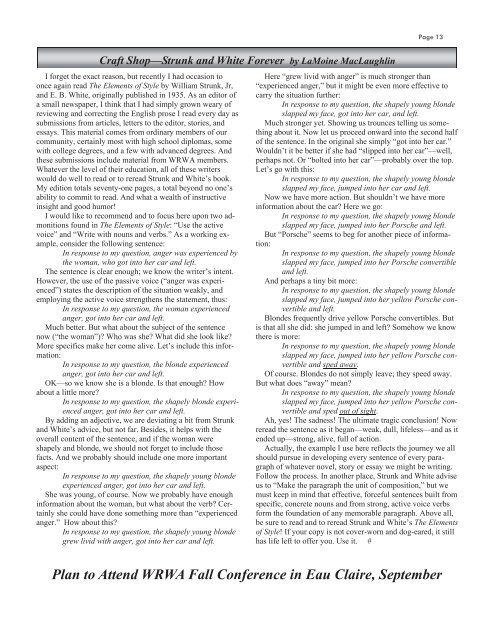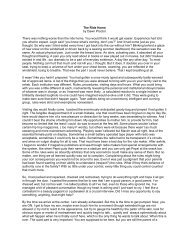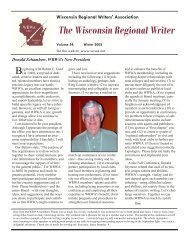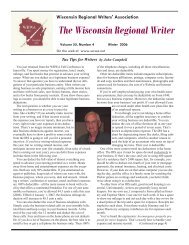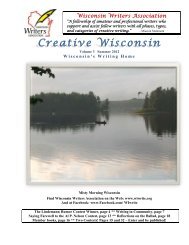2009 Spring - Wisconsin Writers Association
2009 Spring - Wisconsin Writers Association
2009 Spring - Wisconsin Writers Association
Create successful ePaper yourself
Turn your PDF publications into a flip-book with our unique Google optimized e-Paper software.
Page 13Craft Shop—Strunk and White Forever by LaMoine MacLaughlinI forget the exact reason, but recently I had occasion toonce again read The Elements of Style by William Strunk, Jr,and E. B. White, originally published in 1935. As an editor ofa small newspaper, I think that I had simply grown weary ofreviewing and correcting the English prose I read every day assubmissions from articles, letters to the editor, stories, andessays. This material comes from ordinary members of ourcommunity, certainly most with high school diplomas, somewith college degrees, and a few with advanced degrees. Andthese submissions include material from WRWA members.Whatever the level of their education, all of these writerswould do well to read or to reread Strunk and White’s book.My edition totals seventy-one pages, a total beyond no one’sability to commit to read. And what a wealth of instructiveinsight and good humor!I would like to recommend and to focus here upon two admonitionsfound in The Elements of Style: “Use the activevoice” and “Write with nouns and verbs.” As a working example,consider the following sentence:In response to my question, anger was experienced bythe woman, who got into her car and left.The sentence is clear enough; we know the writer’s intent.However, the use of the passive voice (“anger was experienced”)states the description of the situation weakly, andemploying the active voice strengthens the statement, thus:In response to my question, the woman experiencedanger, got into her car and left.Much better. But what about the subject of the sentencenow (“the woman”)? Who was she? What did she look like?More specifics make her come alive. Let’s include this information:In response to my question, the blonde experiencedanger, got into her car and left.OK—so we know she is a blonde. Is that enough? Howabout a little more?In response to my question, the shapely blonde experiencedanger, got into her car and left.By adding an adjective, we are deviating a bit from Strunkand White’s advice, but not far. Besides, it helps with theoverall content of the sentence, and if the woman wereshapely and blonde, we should not forget to include thosefacts. And we probably should include one more importantaspect:In response to my question, the shapely young blondeexperienced anger, got into her car and left.She was young, of course. Now we probably have enoughinformation about the woman, but what about the verb? Certainlyshe could have done something more than “experiencedanger.” How about this?In response to my question, the shapely young blondegrew livid with anger, got into her car and left.Here “grew livid with anger” is much stronger than“experienced anger,” but it might be even more effective tocarry the situation further:In response to my question, the shapely young blondeslapped my face, got into her car, and left.Much stronger yet. Showing us trounces telling us somethingabout it. Now let us proceed onward into the second halfof the sentence. In the original she simply “got into her car.”Wouldn’t it be better if she had “slipped into her car”—well,perhaps not. Or “bolted into her car”—probably over the top.Let’s go with this:In response to my question, the shapely young blondeslapped my face, jumped into her car and left.Now we have more action. But shouldn’t we have moreinformation about the car? Here we go:In response to my question, the shapely young blondeslapped my face, jumped into her Porsche and left.But “Porsche” seems to beg for another piece of information:In response to my question, the shapely young blondeslapped my face, jumped into her Porsche convertibleand left.And perhaps a tiny bit more:In response to my question, the shapely young blondeslapped my face, jumped into her yellow Porsche convertibleand left.Blondes frequently drive yellow Porsche convertibles. Butis that all she did: she jumped in and left? Somehow we knowthere is more:In response to my question, the shapely young blondeslapped my face, jumped into her yellow Porsche convertibleand sped away.Of course. Blondes do not simply leave; they speed away.But what does “away” mean?In response to my question, the shapely young blondeslapped my face, jumped into her yellow Porsche convertibleand sped out of sight.Ah, yes! The sadness! The ultimate tragic conclusion! Nowreread the sentence as it began—weak, dull, lifeless—and as itended up—strong, alive, full of action.Actually, the example I use here reflects the journey we allshould pursue in developing every sentence of every paragraphof whatever novel, story or essay we might be writing.Follow the process. In another place, Strunk and White adviseus to “Make the paragraph the unit of composition,” but wemust keep in mind that effective, forceful sentences built fromspecific, concrete nouns and from strong, active voice verbsform the foundation of any memorable paragraph. Above all,be sure to read and to reread Strunk and White’s The Elementsof Style! If your copy is not cover-worn and dog-eared, it stillhas life left to offer you. Use it. #Plan to Attend WRWA Fall Conference in Eau Claire, September


